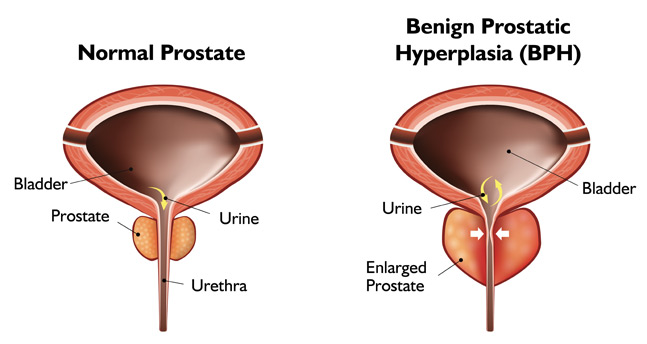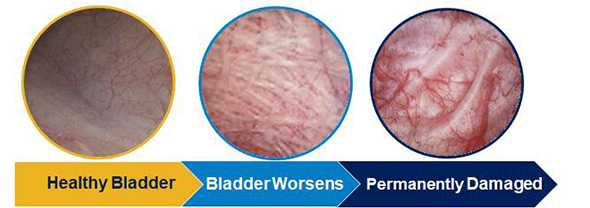What is BPH?
Benign Prostatic Hyperplasia, or BPH, is a condition in which the prostate enlarges as men get older. BPH is a very common condition that affects more than 42 million men in the U.S. and over 660 million men worldwide. Over 40% of men in their 50s and over 70% of men in their 60s have BPH.2 While BPH is a benign condition and unrelated to prostate cancer, it can greatly affect quality of life.
As the prostate enlarges, it presses on and blocks the urethra, causing bothersome urinary symptoms. If left untreated, BPH can lead to permanent bladder damage.
Symptoms include:
- Frequent need to urinate both day and night
- Weak or slow urinary stream
- A sense that you cannot completely empty your bladder
- Difficulty or delay in starting urination
- Urgent feeling of needing to urinate
- A urinary stream that stops and starts
Symptoms of BPH can cause loss of productivity, depression and decreased quality of life. If you suffer from the above symptoms, you are not alone. BPH is the leading reason men visit a urologist.

You can measure your BPH symptoms by taking the International Prostate Symptom Score (IPSS) questionnaire.
Sharing this information with your physician will help them understand the severity of your symptoms.
Take the IPSS Questionnaire

BPH Treatment Options
If you have been diagnosed with an enlarged prostate due to Benign Prostatic Hyperplasia (BPH), consult with your physician to determine which treatment is right for you.
Treatment options may include:
Watchful Waiting: Watchful waiting involves making behavioral changes such as decreasing your fluid intake prior to bedtime, regular physical activity, and avoiding caffeine and alcohol. For men with mild symptoms, this may be a viable option until their condition shows signs of worsening. However, it is important to note that, in a study, 87% of men who elected watchful waiting experienced a worsening of symptoms over a four-year period.
Medications: Your doctor may prescribe BPH medication, just one or even a combination of BPH medications that may help alleviate your urinary symptoms. These medications are effective and may improve your BPH symptoms; however, some men may not experience enough relief. In addition, some men experience bothersome side effects from BPH medication. Either or both of these things may lead them to discontinue the medication.
Minimally Invasive Treatments: These are procedures that can often be done as an outpatient procedure with milder forms of anesthesia than what is used in a hospital operating room. They typically have fewer complications than traditional surgery.
Prostatic Urethral Lift procedures use small implants to open the prostate blockage and do not require heating or cutting tissue. They are typically performed under local anesthesia in a doctor’s office and patients typically return home the same day without a catheter. These procedures offer rapid symptom relief with a low risk profile. As the procedure does not destroy tissue, recovery on average is more rapid than for transurethral resection of the prostate (TURP) patients. It is the only leading BPH procedure shown to provide symptom relief while also preserving sexual function. Patients may experience short-term pelvic pain and light blood in the urine.
* No instances of new, sustained erectile or ejaculatory dysfunction in the L.I.F.T. pivotal study.
Traditional Surgery: Common traditional BPH surgeries include TURP and laser photoselective vaporization of the prostate (GreenLight™ laser PVP). These procedures are the most aggressive treatment option and can be effective. Recovery can take time and is accompanied by a higher risk of complications.



